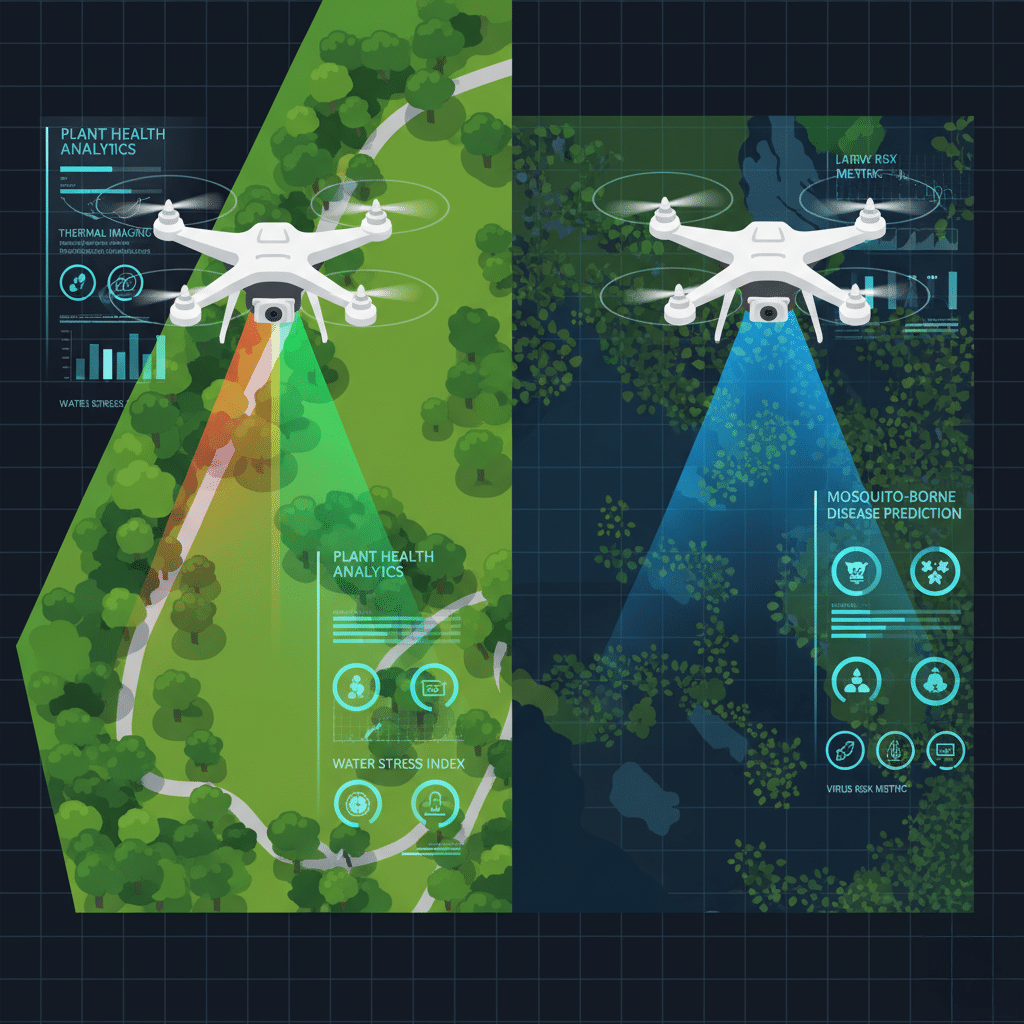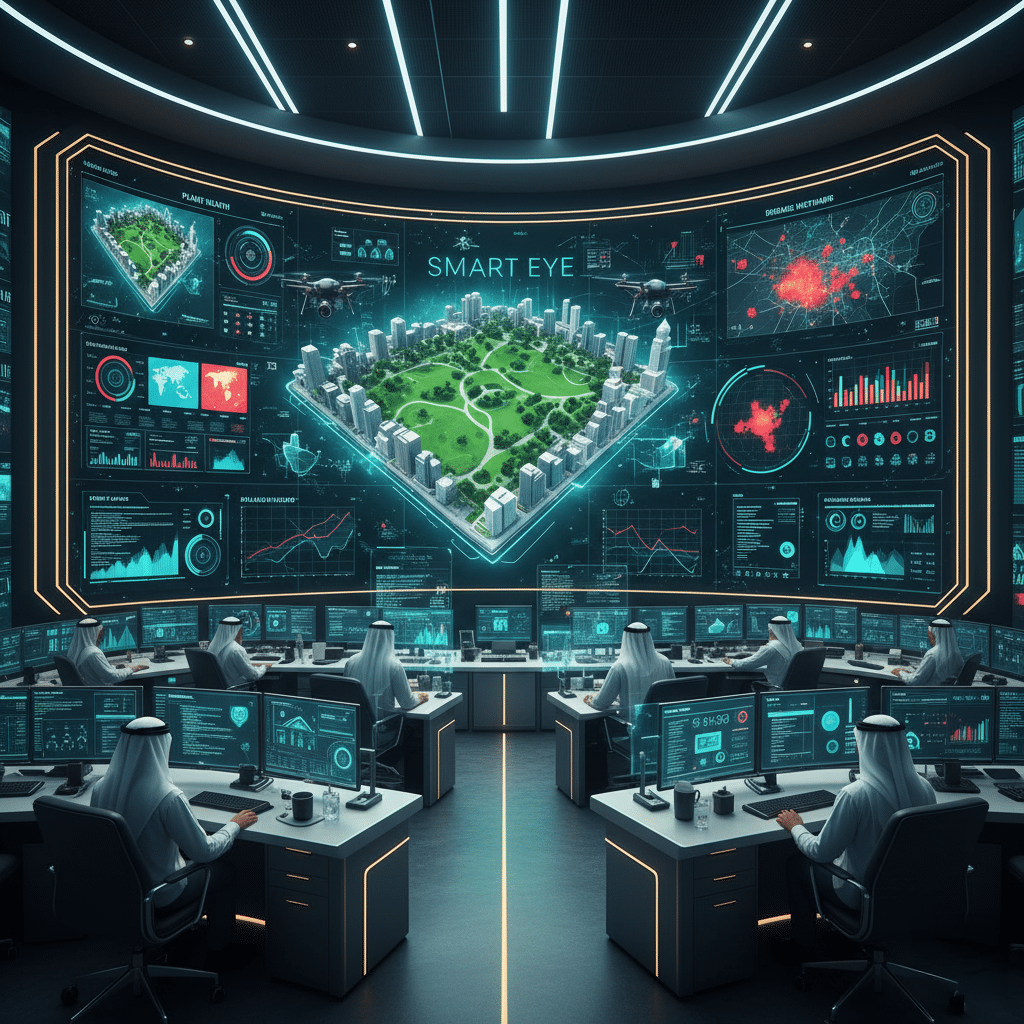In the global race to build the cities of tomorrow, the narrative is shifting. It’s no longer enough for a city to be “smart” by simply reacting to data; the new frontier is becoming proactive, anticipating the needs of its residents before they arise. In a bustling megacity like Dubai, the challenges are immense—from managing public health risks in dense populations to ensuring the sustainability of its ambitious green spaces. The critical question facing urban leaders worldwide is how to move from a reactive posture to one of proactive forecasting and prevention. Dubai Smart Drone Technology is here.
Dubai is answering this question from the sky. This article presents a definitive case study on the emirate’s “Smart Eye” program, a groundbreaking initiative leveraging advanced drone technology to solve critical urban challenges. We will move beyond the headlines to provide an in-depth analysis of how Dubai is creating a practical blueprint for the future of public service. You will learn about the strategic vision driving this innovation, explore detailed case studies in public health and environmental monitoring, and uncover the actionable lessons this program offers to city planners and technology leaders everywhere.
Dubai’s Vision: From Intelligent City to Proactive Urban Future
The deployment of sophisticated drone technology is not an isolated experiment; it is a direct extension of Dubai’s meticulously crafted urban strategy. The city’s leadership is fundamentally redefining what it means to be a smart city, moving beyond passive data collection towards a model of active, predictive governance. This vision is guided by three core pillars, as articulated by Marwan Ahmed Bin Ghalita, Director General of Dubai Municipality (DM).
The first pillar is the transformation from an intelligent city to a forward-looking city that anticipates the needs of its people. The second involves a crucial evolution from sustainability to renewability, ensuring long-term ecological balance. The final pillar focuses on creating new, innovative destinations to attract more visitors and enhance the quality of life for residents[1]. This strategic framework explains the “why” behind investments in programs like Smart Eye—it is about building a city that doesn’t just respond to problems but actively preempts them through technological foresight and urban innovation.
Introducing the ‘Smart Eye’ Program: Dubai’s Drone-Powered Monitoring Solution
At the heart of this proactive vision is the “Smart Eye” program, a strategic initiative designed to integrate a fleet of versatile drones into the core functions of the Dubai Municipality. This program represents a significant leap forward for smart city public services, moving specialized technology from niche applications to a central role in day-to-day urban management.
The program is being rolled out in partnership with Eanan, a private entity building some of the most advanced drones currently used by government entities in the UAE[1]. This public-private collaboration is key to the program’s implementation, combining municipal oversight with cutting-edge technological expertise.
The initial phase of the Smart Eye program is focused and pragmatic, targeting specific, high-impact areas. According to Khulood Mustafawi, a Future Foresight Specialist at Dubai Municipality, the rollout begins with two primary use-case scenarios. “One of them will be to monitor the health of plants and the other will be to sow seeds in large fields,” she explained. “Once we get the feedback from these, we will consider rolling out drones on a larger scale”[1]. This phased approach allows the municipality to gather data, refine operations, and prove the value of drone technology before a city-wide expansion.

Case Study 1: Drones in Public Health – Forecasting Infectious Disease Spread
One of the most critical challenges for any major city is managing urban public health risks, particularly the spread of infectious diseases transmitted by insects or animals. Traditional methods of surveillance and control are often reactive, implemented only after an outbreak has begun. Dubai is tackling this problem head-on through a pioneering application of its drone technology.
As a core component of its future-focused strategy, the Dubai Municipality has signed a formal Memorandum of Understanding (MoU) with the Dubai Health Authority (DHA). This partnership is specifically designed to improve the forecasting of infectious diseases. Fidaa Alhammadi, Head of Strategy and Corporate Development at DM, clarified the objective: “Both entities will work together to predict the possibility of such diseases and eradicate them”[1].
This collaboration will leverage the Smart Eye drone fleet for advanced disease surveillance. Drones equipped with specialized sensors can identify and map potential breeding grounds for vectors like mosquitoes with a speed and precision impossible for ground crews. By analyzing this data, the DHA and DM can move from reaction to prediction, identifying high-risk zones and deploying targeted eradication measures before a disease can take hold. This proactive drone disease surveillance system is a powerful example of how Dubai uses drones for public health, creating a safer environment for its millions of residents and visitors.
Case Study 2: Drones in Environmental Monitoring – Protecting Plant Health & Agriculture
Beyond public health, the Smart Eye program is set to revolutionize how Dubai manages its green infrastructure. The challenge of efficiently monitoring large agricultural areas, public parks, and urban green spaces is significant, requiring immense manpower and resources. Drones offer a powerful solution for proactive environmental stewardship.
As highlighted by Khulood Mustafawi, one of the primary initial applications is using drones for monitoring plant health[1]. Drones equipped with advanced imaging technology, such as multispectral and thermal sensors, can capture data that is invisible to the human eye. This allows them to:
- Detect Stress Early: Identify signs of water stress, nutrient deficiencies, or pest infestations in plants long before they become visually apparent.
- Optimize Resource Use: Pinpoint exactly which areas require water or treatment, reducing waste and ensuring resources are used most effectively.
- Automate Large-Scale Tasks: The second initial use case, sowing seeds in large fields, demonstrates the drones’ capacity to automate labor-intensive agricultural tasks, increasing efficiency and coverage.
By providing a comprehensive, data-rich overview of the city’s green assets, this drone technology for monitoring plant health enables municipal teams to act preemptively. They can address potential problems before they escalate, ensuring the vitality of Dubai’s parks and contributing to the city’s broader goals of renewability and creating attractive public destinations.
The Blueprint for Future Cities: What Urban Planners Can Learn from Dubai
Dubai’s Smart Eye program is more than just an impressive technological deployment; it is a replicable blueprint for urban innovation that holds valuable lessons for city leaders and public policy professionals worldwide. By analyzing its structure and objectives, we can extract a set of core principles for successfully integrating advanced technology into smart city public services.
The success of the initiative is not built on technology alone, but on a foundation of strategic collaboration and clear purpose. The model showcases a powerful synergy between the Dubai Municipality (the end-user and strategist), the Dubai Health Authority (a key public stakeholder), and Eanan (a private sector technology expert). This multi-stakeholder approach ensures that the technology is directly aligned with solving tangible citizen problems.
For city leaders looking to implement similar programs, here are the key actionable insights from Dubai’s model:
- Start with a Clear Strategic Vision: Before deploying any technology, define the overarching goal. Dubai’s vision of a “proactive city” that “preempts the needs of its residents” guides every decision and ensures technology serves a purpose.
- Forge Strong Public-Private Partnerships: Leverage the expertise of the private sector for technology development and implementation while maintaining public oversight and strategic direction. The DM-Eanan partnership is a prime example.
- Prioritize Inter-Agency Collaboration: Break down silos between government departments. The MoU between the Municipality and the Health Authority is critical for tackling complex issues like public health that cross departmental lines.
- Begin with Focused, High-Impact Pilot Programs: Rather than attempting a massive, city-wide rollout at once, identify specific, manageable use cases (like plant health and disease surveillance) to prove the concept, gather data, and build institutional knowledge.
- Focus on Proactive Forecasting, Not Just Reactive Monitoring: The true value of drone and AI technology lies in its ability to predict and prevent problems. Shift the mindset from simply observing the present to actively forecasting and shaping a better future.

Conclusion
Dubai’s ‘Smart Eye’ program is a compelling demonstration of a city moving from science fiction to practical public service. By strategically deploying drone technology, the emirate is not merely adding a futuristic gadget to its toolkit; it is fundamentally upgrading its capacity to protect public health, manage its environment, and create a more responsive and resilient urban landscape.
The initiatives to forecast infectious disease spread and enhance the monitoring of plant health are powerful, real-world applications that solve critical urban challenges. The program’s success is rooted in a clear strategic vision, robust partnerships between public and private entities, and a commitment to using technology to proactively serve its citizens. For urban planners and leaders around the globe, Dubai’s ‘Smart Eye’ offers more than just inspiration—it provides a working blueprint for building the proactive, intelligent, and truly forward-looking cities of the future.
What are your thoughts on the role of drone technology in urban management? Share your insights in the comments below or subscribe for more in-depth case studies on smart city innovations.
Sources
- Statements from Dubai Municipality officials, including Marwan Ahmed Bin Ghalita (Director General), Khulood Mustafawi (Future Foresight Specialist), and Fidaa Alhammadi (Head of Strategy and Corporate Development), during the Urban Future Week held at the Museum of the Future, as reported in the program’s initial announcements.



